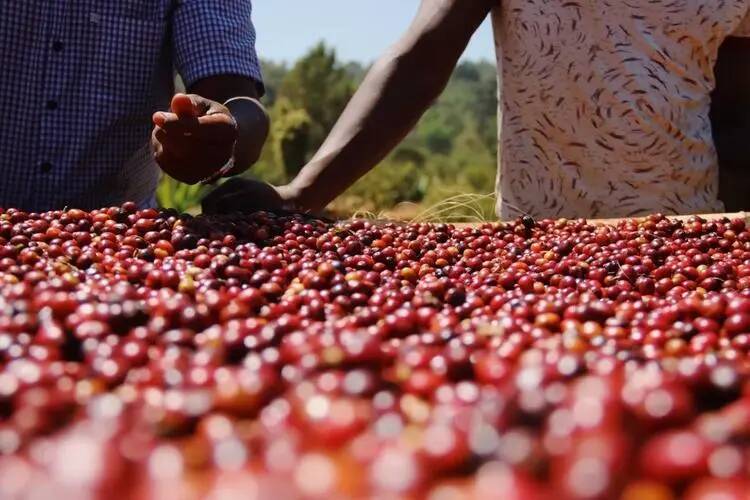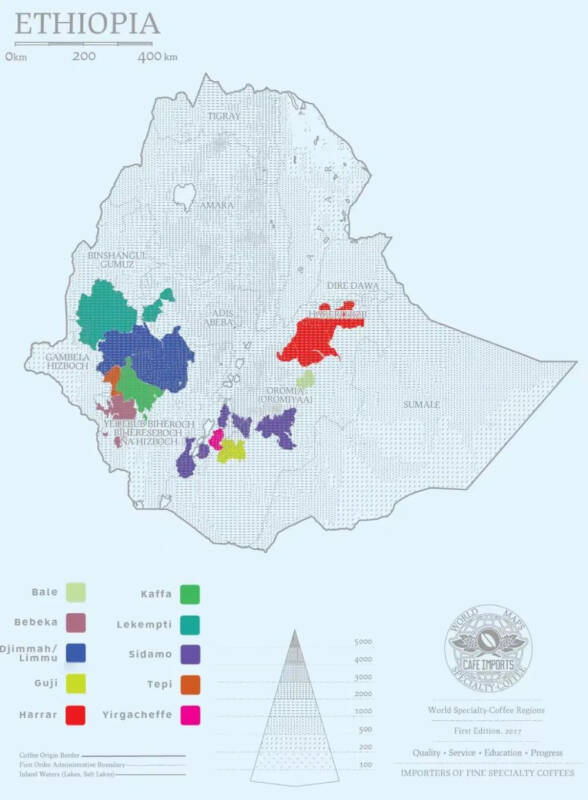Ethiopian Coffee Bean | introduction to Huakui 7.0 of Humbera Buku Abel processing Plant in Guji production area
When it comes to coffee, many people think of Ethiopia, after all, Ethiopia is recognized as the birthplace of coffee. Ethiopia has a long history of coffee, and Ethiopia is the world's largest coffee gene pool, with a wide variety of coffee. It is estimated that there are 10000 to 15000 coffee varieties in Ethiopia today, but most of them have not yet been formally identified.
Ethiopian coffee
Ethiopia is located in the northeast of Africa, which is dominated by mountainous plateaus, which accounts for 2% of the country's total, and the East African Rift Valley runs through the whole territory, with an average elevation of nearly 3000 meters. High altitude, suitable climate and fertile soil give Ethiopia unique natural conditions for growing coffee. It also makes Ethiopia the largest Arabica coffee producer in Africa.

Ethiopia's domestic industry is weak, the national economy is dominated by agriculture, is a traditional agricultural country, so the scale of coffee cultivation is mostly small farmers. Coffee and other crops are grown near the farmers' homes, which are taken care of on a daily basis, picked by themselves during the harvest season, and then purchased by middlemen or sent by farmers to nearby treatment stations. This model accounts for more than half of Ethiopia's total coffee production.
Guji producing area
Ethiopia has many coffee producing areas, among which Guji, Yirgacheffe and Sidama are more famous. Guji Guji, which once belonged to the Sidamo region, was independently classified as a new production area by the Ethiopian Commodity Exchange (ECX) in 2010 because of its excellent and recognizable flavor. The region is located in the south of Ethiopia, with towering mountains, highlands, plateaus, valleys and plains. The terrain is complex and changeable. These rich landforms create a variety of microclimates. The geology belongs to volcanic soil, and most of the area is dense forest that has not been developed or destroyed. The average elevation is more than 1800 meters, and there is a large temperature difference between day and night, which slows down the growth rate of coffee fruit and develops rich flavor in coffee beans. There are also many small producing areas in the Guji producing area, such as Hambella, Uraga, Shakiso and so on, and Humberlain Fakui coffee beans are well known.

Humbera Hambella
Humbela is the birthplace of "Huakui" coffee beans and one of the sub-producing areas that make Guji coffee famous. The west of Humbera is opposite the Cochel Mountains of Yegashefi, planting up to 2100-2300 meters above sea level, and connects to the east and south of Guji's other sub-producing areas of Shakiso and Uraga respectively. The biggest advantage of the place is that it has dense forests and can provide rich natural fertilizers. At present, there are about 20 processing plants of various sizes in Humbela production area, and the harvest period is from November to January of the following year.
Huakui coffee
Huakui Coffee beans are sun-dried beans from DW's "Buku Abel" processing plant in Humbera. The coffee bean became famous in the 2017 TOH (Ethiopia National Taste of Harvest Competition) competition, when Sakui Coffee won the championship with its outstanding strawberry cream flavor. And in the same year, Li Jianfei, the runner-up in China in the World Coffee Brewing Competition, Li Jianfei from Beijing also won the runner-up with Sakui Coffee beans, which also added a lot of fame to Sakui Coffee beans.
Because this bean has a strong strawberry and creamy aroma. Therefore, Chinese importers of raw beans named the bean "Sakuran". Later, DW increased the number of processing plants in Humbera to four, in addition to the original "Buku Abel" to add "Buku Saysay", "Haro Soresa" and "Tirtiro Goye" processing plants, which can produce about 1100 tons of coffee a year. Then it launched Sakuran 2.0 in 2018 and 3.0 and 3.1 in 2019. Since then, the X.0 series has been launched every year, and so far it has been launched to Sakuran 7.0. However, with the expansion and development of DW's processing plant year by year, as well as the increase in production, its flavor is obviously different from that of the famous Huakui coffee beans in 2017.
Qianjie Coffee Ethiopia Guji producing area Huakui 7.0 Coffee producing area: Guji producing area Manor / processing Plant: DW Company Buku Abel processing Plant altitude: 2250-23500 m varieties: original seed treatment method: sun flavor: citrus apricot passion fruit fermented fragrant tea feeling
The current Qianjie Coffee this Huakui 7.0 coffee beans, using sun treatment, light baking, Qianjie using the proportion of V60 1 ℃ 15, 92 ℃ water temperature for brewing, will smell a slight fermented aroma, entrance will have passion fruit-like acidity, citrus, apricot flavor, taste soft, fresh tea.
Important Notice :
前街咖啡 FrontStreet Coffee has moved to new addredd:
FrontStreet Coffee Address: 315,Donghua East Road,GuangZhou
Tel:020 38364473
- Prev

Annoying! Will you be fined for taking out coffee shop food?!
▲ Click to follow | Daily boutique Coffee Culture Magazine Coffee Workshop for many workers, the afternoon tea time of slowly tasting coffee needs to be squeezed out in their busy time, and sometimes they may encounter an emergency that they have to leave ahead of time before they finish drinking coffee, so many consumers will choose to play when buying coffee.
- Next

What is the difference between double washing, K72, dry fermentation washing and ordinary washing?
Water washing is one of the most traditional and common ways to treat raw coffee beans. The process of shelling and washing not only greatly improves the production quality, but also gives the coffee in the cup a good cleanliness. It has become a favorite form of raw bean processing for countless coffee lovers, including Qianjie, of course. With the development of boutique coffee
Related
- Customers have "changed" Manner's new products! Shop assistant: Please don't mess around!
- Remove sockets in customer areas at Starbucks stores?! Netizen: I won't go if I really tear it down
- What is the difference between the taste steps of sun-dried coffee and washed coffee? Why is sun-cured coffee sweeter and washed coffee sour?
- The recipe for salty grapefruit dirty is revealed! Coffee Festival salty grapefruit dirty coffee making materials parameters ratio milk share!
- How about the flavor of Sunlight 74158 at Sidamo Banshaha Mathieu Processing Factory in Ethiopia? 74158 Share the proportion of coffee brewing parameters!
- What effect does Italian American coffee with filter paper have? Will coffee taste better if it is put on filter paper at the bottom of the powder bowl?
- What is the color difference in coffee beans? What are the characteristics of honey processed coffee beans? Why are the anaerobically treated coffee beans uneven in color?
- How does novice Xiaobai quickly get started and make coffee? Newbies learn to make coffee by hand and share the specific steps and process process!
- Costa tea has a shelf life of 100 years?! Expert: Unable to verify
- It's a huge uproar! American milk addition was rejected by Manner employees?!

